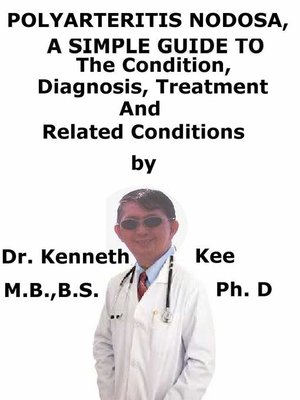Polyarteritis Nodosa, (Updated) a Simple Guide to the Condition, Diagnosis, Treatment and Related Conditions
ebook
By Kenneth Kee

Sign up to save your library
With an OverDrive account, you can save your favorite libraries for at-a-glance information about availability. Find out more about OverDrive accounts.
Find this title in Libby, the library reading app by OverDrive.



Search for a digital library with this title
Title found at these libraries:
| Library Name | Distance |
|---|---|
| Loading... |
This book describes Polyarteritis Nodosa (updated), Diagnosis and Treatment and Related Diseases
Polyarteritis nodosa is a serious blood vessel disease in which small and medium-sized arteries become inflamed and damaged.
PAN was separated into 2 sub-types according to the size of vessel involved in adults:
1.Classical PAN - medium-sized vessels
2.Microscopic polyangiitis (MPA) - small vessels
A less severe form called cutaneous polyarteritis nodosa (CPAN) has also been reported
Causes
Polyarteritis nodosa is a disorder that involves arteries, the blood vessels that transport oxygen-rich blood to organs and tissues.
The cause is not known but it happens when certain immune cells attack the involved arteries.
More adults than children obtain this disease.
The tissues that are supplied by the involved arteries do not get the oxygen and nourishment they require, and become injured.
People with active hepatitis B and C may have this disorder.
Symptoms
Symptoms and signs are due to the inflammation and ischemia of the involved organs.
Any organ may be involved with the exception of the lungs.
Symptoms are produced by injury to involved organs, often the skin, heart, kidneys and nervous system.
1.Abdominal pain
2.Decreased appetite
3.Fatigue
4.Fever
5.Joint aches
6.Muscle aches
7.Unintentional weight loss
8.Weakness
9.Peripheral neuropathy
10.Damage to the nervous system may produce strokes or seizures.
11.Renal involvement may be in the glomeruli or renal vasculature
Diagnosis:
1.Histological evidence of vasculitis
2.Positive serology for ANCA
3.Specific investigations strongly indicative of vasculitis and granuloma-E.g. angiography or skin biopsy
4. Eosinophilia (≥10%)
Investigations
1.Hepatitis B surface antigen is positive in 30%.
2.The p-ANCA test is normally positive, but not pathognomonic.
3.ESR is increased or C-reactive protein (CRP).
4.FBC reveals leukocytosis with raised neutrophils.
5.Hypergammaglobulinemia happens in 30%.
6.Arteriography reveals microaneurysms in the small-sized and medium-sized arteries of the kidneys and abdominal viscera
7.Tissue biopsy
Complications
Without treatment, hypertension-induced glomerulonephritis is a source of great morbidity and mortality.
Treatment
If there is no presence of hepatitis and the symptoms are fairly mild, the doctor normally will start the treatment with a steroid drug, such as prednisone, a powerful medicine that suppresses the immune system and decreases inflammation.
If there is more severe symptoms affecting the heart, nerves or kidneys, if the patient does not improve with initial treatment or if the patient has relapses after initial treatment, prednisone may be combined with an adjunct immunosuppressant medication such as:
1.Cyclophosphamide (Cytoxan)
2.Azathioprine (Imuran),
3.Methotrexate (Rheumatrex),
4.Mycophenolate mofetil (Cellcept) or
5.Rituximab (Rituxan).
Full treatment normally requires at least one year.
If polyarteritis nodosa is linked to hepatitis B or hepatitis C, the patient may be treated with antiviral medicines alone to fight the liver infection.
Antiviral treatment may be added to prednisone to control arterial inflammation
Occasionally, this is accompanied by plasmapheresis
Plasmapheresis is a procedure in which plasma is separated from the blood, cleaned of abnormal antibodies and then returned to the blood.
Updated treatment:
1.Case reports have good response to treatment with tumor necrosis factor inhibitors, such...







